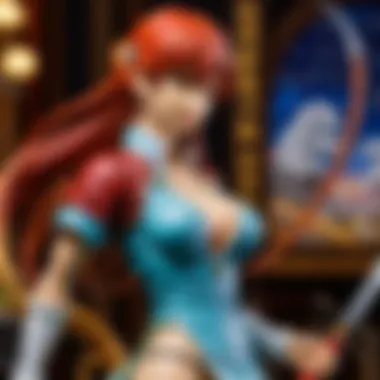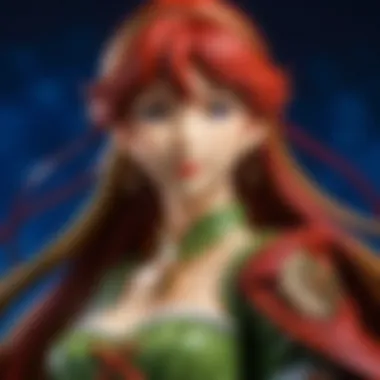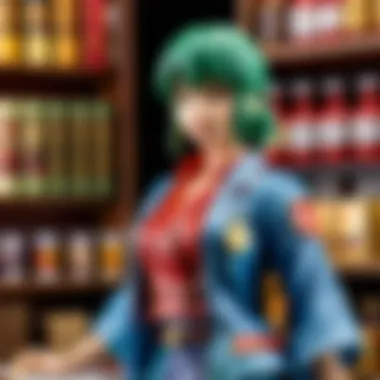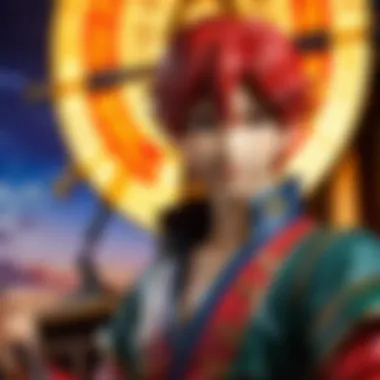Exploring the Cultural Impact of Dies Irae in Anime


Intro
The realm of Japanese animation is not just a visual delight, but a mosaic of cultural narratives and artistic flourishes. One such series that echoes deeply within this intricate landscape is 'Dies Irae'. This anime stands out for its bold thematic exploration and artistic flair, making it a noteworthy subject for analysis. Its layers go beyond mere entertainment, tapping into historical influences and philosophical questions that resonate with audiences.
In this article, we will explore how 'Dies Irae' weaves together various elements that collectively create a rich tapestry of storytelling. We will break down the series into its core components, examining character development, the broader cultural impacts, and the ways in which its aesthetic choices reflect and question current societal norms. Beyond its narrative depth, we will also consider the peculiar relationship between 'Dies Irae' and its merchandise, a market steeped in collector desire and industry trends.
By peeling back the layers of 'Dies Irae', we aim to provide valuable insights for fans, collectors, and those intrigued by pop culture at large. Each section will contribute to a deeper understanding of why this series resonates so profoundly in the anime community.
Prelude to Dies Irae
In the realm of anime, few series manage to carve out as intricate and multifaceted a narrative as Dies Irae. Understanding the foundation of this work is crucial for anyone eager to appreciate its broader implications. This segment provides an overview of the series and explores how its development reflects the complexities of modern storytelling in anime. This introductory section addresses fundamental aspects, such as the thematic depth of the series and the evolution of its narrative structure. In addition, it sets the stage for further exploration into the characters and their arcs, revealing the rich tapestry woven throughout the series.
Overview of the Series
Dies Irae, originally conceptualized as a visual novel, first saw the light in 2015. The anime adaptation, which premiered in 2017, intrigued viewers with its dark, gothic aesthetics and profound philosophical underpinning. At its heart lies a duel between ideologies, set against a backdrop of supernatural elements stemming from European historical contexts.
The series follows Ren Fujii, who is pulled into a chaotic world after the events of a mysterious war. The plot quickly escalates into a confrontation not just among individuals, but also between concepts of fate and free will. As this haunting drama unfolds, viewers are met with an array of characters—each representing various facets of the human condition.
Moreover, it’s essential to recognize the stark themes that run parallel to the compelling visuals. From existential musings to the struggle between light and darkness, these themes paint a vivid picture for the audience, making Dies Irae a rich subject for critique and admiration alike.
Genesis and Development
The roots of Dies Irae can be traced back to its origin as a game developed by light, a company known for producing rich narratives infused with deep philosophical questions. The creative process involved numerous discussions and iterations before it reached its final form, emphasizing the need for a narrative that challenges conventional storytelling.
With inspirations drawn from historical texts like Dante’s Divine Comedy, the creators intended to meld narrative styles and aesthetic choices that resonate with both contemporary and classical themes. The anime adaptation underwent several transformations during development, aiming to capture the essence of its source material while also catering to the medium's unique storytelling capabilities.
As the series evolved, so did its character dynamics. The intricate relationships among characters were designed to reflect moral quandaries and the nature of humanity in the face of adversity. This evolution isn't just a byproduct of storytelling; it encapsulates how audiences interact with these narratives and develop connections beyond the screen.
In summary, the introduction to Dies Irae serves not just as a peripheral glance at the series but opens doors to deeper understanding. The themes and evolution of storytelling that the series showcases can provide anime fans, collectors, and pop culture enthusiasts with invaluable insights as they explore the intricate layers of this captivating work.
Thematic Exploration of Dies Irae
Examining the thematic layers of Dies Irae is crucial for understanding its broader cultural implications in the anime landscape. This series echoes complex narratives that engage with a myriad of philosophical questions, offering viewers more than just surface-level entertainment. In essence, the thematic exploration serves as a bridge connecting the intricate character arcs to the artful animation and sound design, culminating in a cohesive experience.
Central Themes
A thorough assessment of Dies Irae reveals several core themes that not only drive the plot but also resonate deeply with audiences. One prominent theme is the constant struggle between good and evil. Characters find themselves caught in eternal conflicts, questioning their beliefs and morality. The use of historical figures and metaphysical elements adds a layer of depth, encouraging viewers to reflect on their own understanding of justice and righteousness.
Moreover, identity and self-discovery are notably significant. As characters grapple with their pasts and internal demons, they embark on journeys of transformation. This theme speaks profoundly to anyone who has ever faced self-doubt or an identity crisis, making the narrative broadly relatable, despite its fantastical elements.
Philosophical Undertones
Delving into the philosophical underpinnings of Dies Irae, we discover connections to existentialism and nihilism. The series doesn't shy away from tackling questions about existence and purpose. For example, certain characters embody Nietzschean ideas, grappling with the concept of the Übermensch as they seek to define their own paths in a chaotic world. As they confront their limitations and devise means to transcend them, audiences are left contemplating the very nature of existence.
Furthermore, themes like fate versus free will emerge throughout the series. Are the characters’ actions a result of destiny, or can they actively change the course of their lives? This age-old debate is woven into the narrative fabric of Dies Irae, inviting viewers to reflect on their own lives and the forces that shape their choices.
Influence of Historical Texts
The influence of historical literature cannot be overlooked in Dies Irae. The series cleverly integrates elements from literary classics and historical texts. For instance, the references to The Divine Comedy spark points of discussion around judgment and redemption, while Karl Marx's ideas about society permeate the dialogues among characters. This intertwining of history and narrative underscores the rich tapestry of cultural influences that the series draws from, enriching the viewer’s experience.
Thus, the thematic exploration of Dies Irae acts as a crucial lens through which audiences can dissect and appreciate its cultural impact. By navigating the currents of morality, identity, and historical discourse, the series manages to bridge past and present, granting it a unique significance in contemporary anime.


Character Analysis
Character analysis is a cornerstone of understanding any narrative, and when it comes to Dies Irae, its fleshed-out personas are what truly captivate the audience. The characters are not merely vehicles for the plot; they embody the intricate themes and philosophies that Dies Irae aims to portray. By delving into character motivations, relationships, and transformations throughout the anime, viewers can gain a deeper appreciation for the overarching narrative as well as the subtleties embedded within.
Protagonists and Antagonists
At the heart of Dies Irae lies a rich tapestry of protagonists and antagonists who are deeply interwoven in a battle not just of powers, but of ideologies. The main character, Ren Fuji, finds himself torn between duty and morality, representing the struggle that many face in real life. His journey is something we can all resonate with on some level.
On the flip side, we have the main antagonist, the enigmatic Friedrich von Eins, whose motives are shrouded in layers of complexity. His portrayal isn't that of a typical villain, which adds a unique twist, inviting us to ponder his beliefs and the reasoning behind his actions. This dichotomy offers an engaging viewing experience, pushing us to reflect on the nature of good and evil.
"Characters are not mere reflections of a narrative; they are its pulse, driving emotions and thoughts to the surface."
Supporting Characters
Supporting characters in Dies Irae are anything but one-dimensional. They serve as both foils and sources of insight into the main characters' struggles. Take the character of Shirou, for instance. He adds layers to Ren's development, serving as a friend but also presenting a contrasting perspective that keeps the audience questioning the boundaries of friendship and loyalty.
Moreover, characters like Marie and Kasumi serve to highlight the emotional stakes of the story. They each carry their own baggage and contribute to the broader emotional palette of the narrative. This array of supporting characters doesn’t just add depth; they remind the audience that every hero needs allies and that every villain has a past, making the narrative all the more impactful.
Character Arcs and Development
As viewers traverse through the episodes, one can’t help but notice the profound evolution of characters as they face various trials. Ren's character arc is particularly noteworthy, shifting from a seemingly carefree individual into a multi-faceted protagonist dealing with existential quandaries. His encounters shape him in ways that resonate with personal growth, allowing viewers to witness a powerful transformation.
Other characters also undergo significant changes, reflecting on their motivations and relationships. The narrative does not shy away from presenting these transformations with authenticity, which is a breath of fresh air considering how often characters can feel stagnant in many series.
Through exploring these character arcs, one can garner lessons about resilience and introspection. In the world of Dies Irae, every character has a purpose, and understanding their journeys lends a comprehensive perspective on the series’ thematic essence.
Ultimately, character analysis in Dies Irae is paramount to grasping the depth of storytelling and thematic exploration present in the series. The intricate relationships and well-crafted character development serve not just to entertain, but to provoke thought, discussion, and, most importantly, a sense of connection for the audience.
Artistic and Aesthetic Elements
Exploring the artistic and aesthetic elements of Dies Irae is crucial in understanding its overall impact and resonance with audiences. The way the series visually articulates its themes and the emotions conveyed through its art significantly influence viewer perceptions and interpretations. From character design to color palettes, every artistic choice serves a purpose, enhancing the narrative while enriching the viewing experience. Such details not only attract attention during initial viewings but also leave a lasting impression, compelling viewers to revisit and analyze these choices.
Visual Style
One of the standout features of Dies Irae is its distinctive visual style. It strikes a balance between dark themes and vibrant artistry. The rich color schemes create a nostalgic yet unsettling atmosphere. For example, the use of striking reds and deep blacks highlights the themes of violence and anguish that permeate the storyline.
The character designs are also noteworthy; they combine both traditional anime aesthetics and elements that seem to draw from gothic or baroque influences. This mix appeals to a wide spectrum of viewers, from hardcore anime fans to casual watchers. The characters often possess extravagant costumes that not only serve to visually distinguish them but also reflect their personalities and roles within the story.
"The art style of Dies Irae functions almost like a character in itself, shaping the audience's emotional journey."
Symbolism in Design
Symbolism plays a vital role in Dies Irae. Each character carries visual motifs that enhance the storytelling. For instance, the protagonist’s attire may feature specific color accents or patterns that allude to his inner struggles or aims. These design choices do not go unnoticed; they whisper layers of meaning that significantly deepen the audience’s engagement with the narrative.
The use of imagery is notable, too. Imagery related to death, rebirth, and existential questions illuminates character interactions and pivotal scenes. For instance, the frequent portrayal of roses in contrasting states—blooming or wilting—symbolizes the fragility of life and the impacts of choices made by the characters. Such symbols act as silent narrators, unraveling deeper connections to the story without explicitly stating them.
Animation Techniques
The animation techniques employed in Dies Irae add another layer to its artistic integrity. Notably, the series uses a blend of 2D and 3D animation that results in a dynamic and fluid visual experience. This technique allows for intricate battles and emotionally charged scenes that feel both immersive and potent.
The pacing of the animation, particularly during critical plot developments, further enhances the emotions conveyed. Rapid cuts, slow motion, and unique angle shots are applied when the stakes are high or the atmosphere requires a shift in tension.
Moreover, sound design works in tandem with the animations, ensuring that visuals are paired with evocative soundscapes, often pulling the viewer deeper into the drama of each moment. It’s through this meticulous attention to detail that Dies Irae establishes itself not merely as a visual feast but as an experience that transcends conventional storytelling.


In summary, the artistic and aesthetic elements of Dies Irae encapsulate a carefully woven tapestry that brings to life its complex narratives and themes. The visual style, symbolism in design, and innovative animation techniques all contribute to the fabric of this remarkable series, proving that art in anime is not just decoration but a critical storytelling device.
Narrative Structure and Storytelling
Understanding the narrative structure and storytelling within Dies Irae provides an essential lens through which to appreciate the series. Narratives are more than just a sequence of events; they are intricate webs that interconnect characters, themes, and the overall mood of the story. In Dies Irae, the storytelling is not merely a backdrop for character actions, but a crucial component that shapes the viewer's experience and emotional response.
Plot Mechanics
The plot mechanics of Dies Irae are compellingly layered, rich with twists and turns that keep the audience engaged. The series employs a non-linear narrative approach, weaving together multiple timelines and perspectives. This structure challenges the viewer's perception of time and prompts them to piece together the overarching story. Each episode strategically reveals new information, encouraging fans to critically analyze the connections between characters and events.
- Foreshadowing and Echoes: The use of foreshadowing is notable; hints about character motivations and future events are often subtly embedded in dialogue or visual elements. For instance, a seemingly inconspicuous conversation can later be pivotal, showcasing how deep and reflective the writers were in crafting the plot.
- Character Interrelations: The intertwining arcs of protagonists and antagonists enhance the plot mechanics. Their pasts are not just backstories but are integral to understanding conflicts that drive the current plot. In many respects, the series invites the viewer not just to observe but to question the very essence of morality and decision-making.
Pacing and Tone
Pacing is a double-edged sword in storytelling, and Dies Irae strikes a delicate balance. The initial episodes may unfold at a leisurely pace, allowing for character development and world-building, which sets a solid foundation. However, as tensions escalate, the pacing picks up, creating a sense of urgency that propels the story toward its climax. This rhythm not only keeps the viewers on their toes but also mirrors the inner turmoil experienced by the characters.
- Gradual Tension Buildup: The narrative architecture is notable for its gradual tension buildup, expertly maintaining suspense that captivates collectors and anime fans alike. Each episode peels away layers of mystery without rushing to revelations, much like unwrapping a complex gift over time.
- Mood Consistency: The tone shifts seamlessly throughout the series, ranging from the introspective and melancholic to the outright intense. This tonal variety helps to maintain viewer attention while also allowing for a reflective experience that resonates long after the credits roll.
"The mastery of Dies Irae lies in its ability to manipulate both pacing and tone, creating a tapestry that speaks to the complexities of the human experience."
In essence, the narrative structure and storytelling in Dies Irae do not merely serve the plot; they define its essence. This multifaceted approach ultimately enhances its cultural impact, encouraging viewers to engage deeply and thoughtfully with the anime's myriad elements, making it a worthy topic for any discerning anime enthusiast.
Cultural Impact of Dies Irae
The cultural footprints of any anime often extend far deeper than the surface narrative or aesthetic appeal. In the case of Dies Irae, its significance resonates through several layers of contemporary anime culture, creating ripples that exceed mere entertainment. This section highlights the various dimensions of its impact, examining not just how audiences consume this work, but also how it shapes and reflects broader trends within the genre.
Audience Reception
When Dies Irae first hit the screens, it was met with a wave of anticipation. Fans of visual novels were eager to see how the rich textures of the original game would manifest in animated form. As episodes rolled out, viewers found themselves grappling with a multifaceted narrative that pushed their understanding of anime storytelling. Audience feedback varied widely; some hailed it as a masterstroke of animation and narrative complexity, while others felt the plot didn’t fully capitalize on its potential.
This dichotomy showcases a fundamental truth about Dies Irae—its demand for active viewer engagement. By choosing intricate themes that interweave philosophy, history, and modern-day dilemmas, it wasn't just a passive viewing experience. Several discussions on platforms like Reddit highlighted the friction between what was expected and what was delivered, prompting deeper dialogues about narrative expectations in anime. The mixed responses paved the way for a more involved anime community, one that not only celebrates the series but critically interrogates its elements.
"Anime serves not just as content to be consumed, but as a communal experience to be dissected and debated," observed one fan in a heated discussion on social media.
This idea arguably captures the essence of Dies Irae: it's not just watched; it's experienced and questioned.
Critical Acclaim
Beyond its audience reception lies the essential aspect of critical acclaim. Critics were swift to recognize the ambitious storytelling attempts within Dies Irae. It drew comparisons across centuries, weaving historical allegories that resonated with modern audiences. Critics often noted the show’s compelling visual style and character depth, alongside its implicit commentary on socio-political issues—a feature that many anime miss entirely.
A review on Britannica emphasized the deft hand of the creators in intertwining visuals, audio, and narrative. Their artful blend invites viewers into a world steeped in gore and complexity, creating an aesthetic that feels both oppressive and mesmerizing at the same time. Such distinctive characteristics earned Dies Irae significant accolades in animation circles, potentially influencing similar productions.
Moreover, critical discussions frequently spotlight the ambitious orchestral scores that amplify the drama on screen, connecting empathetically with viewers. Critics noted how these score choices are not just background music; they're vital elements that accentuate the emotional thrust of the scenes.
In summary, Dies Irae embodies a unique convergence of audience engagement and critical discussions, underscoring its lasting relevance in the social fabric of anime culture.
Merchandising and Collectibility
The intricate world of anime merchandise can oftentimes echo the very themes and narratives that are prominent within the series itself. In the case of "Dies Irae," this connection between the series and its collectibles serves as a crucial lens through which we can understand its impact on fans and broader pop culture. The importance of merchandising within this context isn’t merely about generating revenue; it's about fostering a sense of community among collectors and enthusiasts, and preserving the legacy of the anime in question.
For many fans, owning a piece of merchandise translates to a tangible connection with the universe of "Dies Irae." Items such as action figures, art prints, and wall scrolls do more than just adorn shelves; they evoke nostalgia while offering a physical reminder of the characters and stories that resonate deeply with individuals. This intertwining of emotion and commerce forms a significant part of the anime landscape, making it a compelling area of exploration.
Merchandise Trends


Recent trends in anime merchandise for "Dies Irae" suggest a shift not only in what fans desire but also in how those items are produced and sold. There’s been a notable increase in limited edition collectibles, which can create a sense of urgency and exclusivity, enticing collectors to purchase items as soon as they drop.
Popular trends include:
- High-detail figures: These capture the aesthetic intricacies of characters, appealing to both collectors and artists.
- Artwork books and illustration collections: Offering insight into the design process, these items cater to an audience that appreciates the behind-the-scenes aspects of the anime.
- Wearable merchandise: From t-shirts to jackets, fashion items that feature "Dies Irae" designs help fans express their passion in everyday life.
The rise of platforms like social media has also amplified the visibility of merchandise. Fans share their collections online, influencing others to seek out items that pique their interest. This sense of community plays a vital role in fostering a vibrant collector’s market.
NipToys: Your Source for Collectibles
In the realm of anime collectibles, few platforms have made a name as effectively as NipToys. This online store specializes in catering to the passionate fanbase of franchises including "Dies Irae," allowing collectors access to a plethora of products that range from exclusive figures to hard-to-find items. NipToys offers an extensive catalog specifically designed for enthusiasts looking to expand their collections.
Some standout features of NipToys include:
- Limited Edition Releases: NipToys often collaborates with manufacturers for exclusive items, which elevates the collectibility factor.
- Preorders on Upcoming Releases: This feature allows fans to secure items ahead of time, making sure they don’t miss out on coveted merchandise.
- Community Engagement: Through their social media channels, NipToys engages in discussions with fans, taking feedback that helps tailor their inventory to meet collectors’ desires.
The strategic approach of stores like NipToys illustrates how merchandising transcends mere commerce; it cultivates a sense of belonging among fans, tying them closer to the worlds they love.
The Future of Dies Irae in the Anime Landscape
As the anime industry continues to evolve, the future of Dies Irae remains an intriguing topic. Its rich narrative and thematic depth provide fertile ground for potential continuations and adaptations. Given the current appetite for sequels and remakes in the anime landscape, exploring the future possibilities of this series could reveal new dimensions for both its characters and story arcs. Discussing the envisioned paths that Dies Irae might follow also sheds light on the lingering questions of its cultural relevance in an era where anime is constantly pushing boundaries.
Potential Continuations
Looking ahead, the potential for continuations of Dies Irae can be mapped through several trajectories:
- New adaptations: Given the original visual novel's narrative complexity, there is scope for more detailed animated adaptations, focusing on uncharted storylines and character developments that can resonate with fans old and new.
- Spin-offs: The diverse cast and intricate lore create opportunities for spin-offs. Stories centered on secondary characters, delving into their pasts or alternate dimensions, could pique interest and add layers to the existing narrative.
- Cross-media explorations: There’s a growing trend in anime to venture into various media like games and novels. Dies Irae can capitalize on this by adapting its storyline into interactive experiences, engaging fans in new ways.
This exploration of potential continuations emphasizes the adaptability of Dies Irae within the anime medium, capitalizing on its established fanbase while attracting new viewers.
Legacy within Anime Culture
The impact of Dies Irae on anime culture runs deeper than casual observations. Here are some elements that highlight its significance:
- Symbolism and Aesthetic Influence: The series’ visual flair and thematic symbolism have inspired numerous works within the genre, affecting the styles of newer productions. This influence can be traced in various titles that follow its unique artistic approach.
- Community and Fandom: The series has fostered a passionate community, where discussions stretch beyond mere viewership into the realms of philosophical debates and artistic critiques. This engagement tends to resonate with a thoughtful audience, further integrating Dies Irae into the fabric of anime culture.
- Merchandising Impact: As a cornerstone of collectible culture, especially amongst NipToys enthusiasts, Dies Irae collectibles have risen in popularity, showcasing its cultural capital within the merchandising arena.
Overall, the legacy of Dies Irae within anime culture is marked by its ability to evoke in-depth dialogues among fans and creators alike. Its aesthetic and thematic contributions pose questions and insights that could influence successive generations of anime creators, allowing Dies Irae to remain not just relevant but impactful in the unfolding narrative of anime.
"The future of Dies Irae is not just limited to what’s next on-screen, but expands into how it influences the broader anime narrative and fan culture."
Closure
In summarizing the intricate layers explored throughout this article on the anime series Dies Irae, it becomes clear that the significance of the topic rests not just in its narrative or art but in the profound impact it has on its fans and the wider anime community. This examination delved into the thematic richness and aesthetic elements that set Dies Irae apart, allowing for a unique insight into how these components resonate with viewers on various levels.
The conversation about Dies Irae highlights specific elements that make it essential within the anime spectrum: themes of morality, the balance between good and evil, and a deep dive into historical influences. Each character's path intricately weaves into the broader context, emphasizing personal and collective struggles that many viewers can relate to, making it not just a series but a collective experience.
Summation of Key Insights
- The series combines philosophical questions with intense character exploration, drawing on historical and literary references that enrich the narrative.
- Visual style and animation techniques contribute significantly to the atmosphere, enhancing the storytelling experience.
- The cultural reception of Dies Irae reveals its legacy and ongoing relevance in discussions about morality, identity, and the human experience.
- Merchandise, particularly collectibles, bridges the gap between the series and its fans, fostering a community of enthusiasts and collectors.
Despite its challenges, Dies Irae proves how anime can encapsulate deep philosophical inquiries and engage fans with richly developed aesthetics and character arcs.
Closing Thoughts
The adventure through the multifaceted world of Dies Irae brings forth the invaluable takeaway that anime is more than entertainment; it's a conduit for exploring complex ideas. In a landscape saturated with content, Dies Irae stands as a testament to how art can communicate profound questions about existence, culture, and human emotion.
As the anime community continues to evolve, the discussions ignited by series like Dies Irae will usher in new conversations, ensuring its place in the broader dialogue of anime's impact on culture. For collectors and enthusiasts alike, understanding these elements not only deepens one's appreciation of the series but also enriches one’s connection to the collectible culture that flourishes around it. Fans who engage with Dies Irae are not just viewers; they are part of a larger narrative—a community united by a shared love for the depth and complexity that anime can offer.
Ultimately, Dies Irae serves as a reminder that the stories we consume shape our understanding of ourselves and each other in this ever-complex world.



